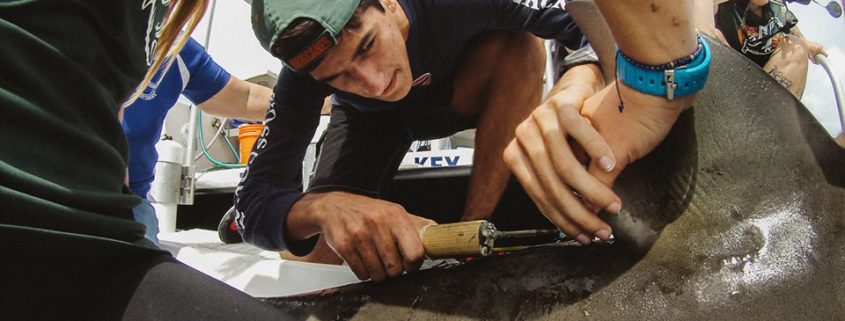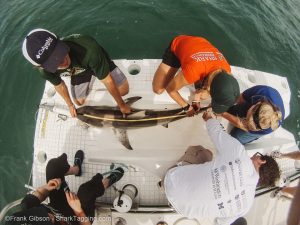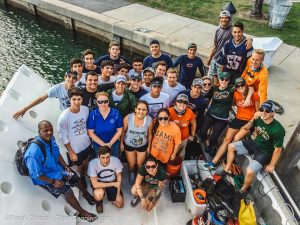Shark Tagging with Christopher Columbus High School
By Shannon Moorhead, RJD Intern
The sun was just beginning to rise as my fellow intern, Grace Roskar, and I began our drive to Crandon Marina. On a typical day, waking up so early would leave me tired and irritable, but it’s hard not to be in a good mood when you have a day of shark tagging to look forward to. We met with the rest of the RJD team at 8, loaded up Diver’s Paradise with the equipment we’d need for the day, and, once our school group was ready, set out to tag some sharks!
As the team cut bait and prepared the drumlines for deployment, our trip leader Pat Goebel briefed the students on our fishing gear and how they would be assisting in our research. This trip we were joined by Christopher Columbus High School, and they were the most energetic group I’d seen yet! The boys divided themselves into four teams (which they dubbed Banana, Nemo, Clasper, and Pumpkin Spice) to take turns participating in such critical tasks as taking a fin clipping, measuring, and, most importantly, tagging the sharks. After the short trip to Stiltsville, a community of houses built on stilts above the waters of Biscayne Bay and our site for the day, the team set two fish traps. These wire mesh cages are baited to attract nearby fish and give us insight as to what species the sharks are sharing a habitat with. Then, students helped us deploy the first set of 10 drumlines; spirits were high as each line set was met with a round of cheers and applause from the enthusiastic Christopher Columbus High.
After the students assisted us with some environmental measurements and the lines had soaked for an hour, we returned to the first drum. When a Christopher Columbus student hauled the drum onto the boat, it was apparent we were sharkless for now. However, we didn’t have to wait long. Team Banana, proving the fruit may not be bad luck on boats after all, suggested the use of a banana-colored yo-yo (plastic ring monofilament is wrapped around)to pull in the line on drum #4 and sure enough, there was a shark on! The smallest shark of the day, measuring 1.5 meters (a little over 5 feet), the male blacktip fought hard, running all over the place before we got him on the boat. Once the shark was secured on the platform, Christopher Columbus students assisted the team with data collection while graduate interns drew blood and took morphological measurements. The whole process was done in about five minutes and the blacktip swam off in great condition!

Trip leader Pat Goebel and graduate intern Julia Whidden affix a satellite tag to the dorsal of a huge female bull shark.
There were no sharks to be found on the remaining lines of the first set, but hopes were still high. The boys of Christopher Columbus High kept up the energy by singing, treating the team to rousing renditions of tunes ranging from “Bennie and the Jets” to “Hotline Bling”. “I’ve never met a group of high school boys that likes to sing acapella more” said graduate intern Julia Whidden. Apparently, the sharks enjoyed the music because on the fourth drum of the second set we had another shark; this time it was a massive female bull shark, 2.7 meters (almost 9 feet) long! She was enormous, there was barely enough room for the team on the platform with her. While the RJD team and Christopher Columbus students performed the usual workup, a satellite tag, generously provided by citizen scientist Nika Hosseini, was attached to the shark’s dorsal fin. Satellite tagging a new shark is very exciting because it provides us with data that can help answer important questions about shark movement patterns, habitat preference, and vulnerability.

Undergraduate intern Grace Roskar helps a Christopher Columbus student apply a dart tag to a bull shark.
We stayed very busy the rest of the day, catching a total of 7 sharks! We landed a 1.9 meter (6.5 ft) feisty female nurse shark, a small 1.8 meter (6.2 ft) male bull, and three female blacktips, ranging from 1.6-1.7 meters (5.2-5.7 ft). Once the last drumline was hauled in, we made our way back to the fish traps. The team measured and photographed the fish caught, primarily pinfish, and returned them to the ocean while the boat headed back to the marina. This was a great trip; not only did we gain data on several sharks of three species, but we got to deploy a new satellite tag that will gain valuable data on the movement of the bull shark. The day was made even better by the fantastic attitudes of the students of Christopher Columbus High. Thank you for your hard work and enthusiasm, hope to see you on the boat again soon!






Leave a Reply
Want to join the discussion?Feel free to contribute!